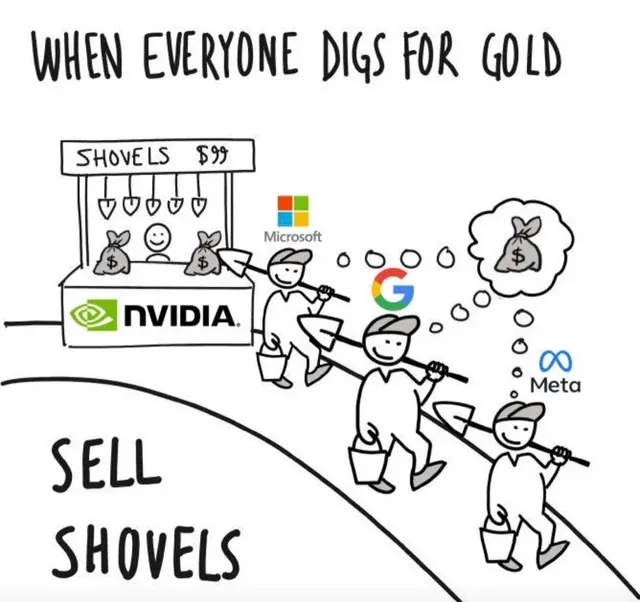how much computing power to mine a single coin?

The processing power required to support the AI revolution is a staggering figure, but computing power is a really hard thing to visualize. The scale of the numbers are so huge that it numbs the brain.
So how can we visualize the massive amount of computing power required to support the AI revolution?
Frankly...it's really hard. The best way I can think of is to visualize computing power relative to something physical. Like gold.

This meme started circulating around the time that NVIDIA crossed the 1T valuation mark and it illustrates a really interesting point.
There is money to be made in the AI revolution (duh) but there are inherent costs in running AI platforms:
- CapEx depreciation
- Electrical power
There are also opportunity costs:
- Computing power spent running an LLM is computing power NOT used to mine cryptocurrency.
To support the visualization, we'll have to make a few assumptions that will probably make a lot of AI/crypto nerds mad. Also economists.
Assumption 1: Computing power is computing power. ASIC, GPU, whatever else...for the purposes of this article we will only worry about the number of operations the processor can perform in a set amount of time
Assumption 2: AI/Chip markets are perfectly efficient.
How does this help us visualize computing power?
Well...we can expand on the gold rush metaphor by imagining the following:
- 1 Bitcoin is the "gold"
- Each hash required is a grain of sand
- Computing hardware is the shovel
This gives us a clear way to tie computational power to a monetary outcome. We have a nugget of digital gold buried under a pile of computational sand.
A high performance NVIDIA GPU (Note 1) is good for about about 50 million hashes per second. If we assume a grain of sand is about 0.0654 mm³ this means that every second our GPU shovel moves about 3 liters of digital dirt.
Coincidentally, this is about how much actual dirt you can fit on a large shovel.
The metaphor isn't perfect, because a normal person would keel over trying to move that much dirt that fast, but at least it gives us a structure to start visualizing the insane number of computations performed by these incredible pieces of hardware.
So how big is the pile of digital dirt we need to move with our GPU shovels before we get to the gold?
Pretty big.
Per my 5 second internet search:
"As of Monday, August 26, 2024, it would take 3,543.3 days to mine 1 Bitcoin at the current Bitcoin difficulty level along with the mining hashrate and block reward; a Bitcoin mining hashrate of 390.00 TH/s consuming 7,215.00 watts of power at $0.05 per kWh, and a block reward of 3.125 BTC."
So 3543.3 days of calculations (hashes) at a rate of 390,000,000,000,000 hashes every second?!
This is going to be a big pile.
Math time!
3543.3 days * 24 hours/day * 60 minutes/hr 60 seconds/minute390,000,000,000,000 hashes per second: 119,395,036,800,000,000,000,000 hashes
$30,677.89 of power consumed (at $.05 per kWh)!
The $ I can visualize, the hashes...nope. So now the grain of sand comes into play (also more math). I asked Dystr how tall a pile of 119,395,036,800,000,000,000,000 sand grains would be and here's the result:
119,395,036,800,000,000,000,000 grains of sand have a volume of 7,808,435,406.72 cubic meters
Our single digital nugget (1 btc worth $63,000 USD or about .7 kg of gold) buried under enough computational sand to bury the entire city of San Francisco 65 meters deep.
It would require a decade of shoveling (with 7800 of our 50 MH/s GPUs).
This is an insane number!
Speaking of insane, did you know that microchips are size limited by the speed of light? A chip can only be about 40mm wide because if they got any wider, electricity traveling at the speed of light wouldn't have time to reach the other side of the before the state change signal is sent. This is why in mid 2000s manufacturers started going to multi-core chips. Interesting side note, in an early attempt to solve this problem, scientists developed a computational cube instead of a chip.
Which melted down almost instantly because it was impossible to cool the core.
I lost track of my point along time ago, but when I start thinking about the sheer volume of computations required for an LLM to put together responses to my dumb questions I feel a little guilty for asking them to "Rewrite the Declaration of Independence in the style of a 1990's hip hop diss track". Note 2
NOTES:
1. I realize that GPUs aren't great for mining Bitcoin but I am going to ignore this and use GPUs and Bitcoin for the remainder of the article anyway though because absolutely no one is going to take this seriously if I start talking about ASIC miners or Doge.
2. I did it anyway:
Yo, listen up, King George, we got somethin' to say,
We breakin' free, no more games, we ain't here to play.
You been taxin' and actin' like you own this land,
But we the real deal, got our own master plan.
We declare our independence, yeah, we takin' a stand,
No more tyranny, we demand our own brand.
You tried to hold us down, but we rise like a crew,
Thirteen colonies strong, we comin' for you.
We got rights, life, liberty, and the pursuit of happiness,
You can't stop this flow, we bringin' the realness.
Unalienable rights, that's what we claim,
In this diss track, we callin' out your name.
So step back, King, your reign's about to end,
We the United States, got freedom to defend.
This is our declaration, our lyrical attack,
In the style of the 90's, we takin' our power back.



